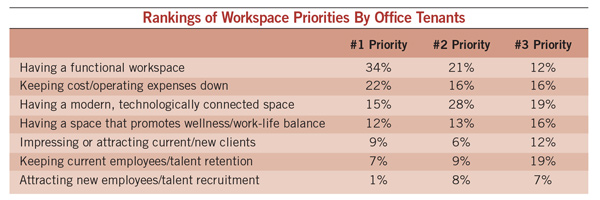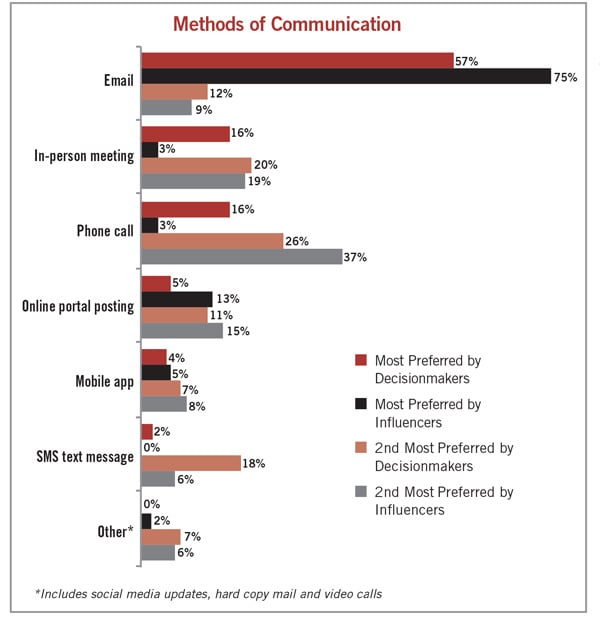Tenant Communications: Connecting With People Who Are Always Connected

How you say things says a lot, and can have a big impact on tenant retention and rent premiums.
COMMUNICATION IS AN age-old problem. The audience you are trying to reach may indeed see but never perceive; they may hear but never understand. In 1950, urbanist and organizational analyst William H. Whyte noted in Fortune: “The great enemy of communication, we find, is the illusion of it.”
Despite vast enhancements to communications in the past 67 years, the core problem remains: All of us are quite certain that because we have said something, we have communicated. Often, however, we haven’t.
Connection Matters
In today’s world, information is a commodity. The resource in short supply is attention. Therefore, it is more important than ever that you focus your communications on what creates value for you, based on what is valued by your tenants. Everything else is just noise.

Michael Broder
Commercial real estate companies are pretty good about making information available. But is it the right information? Is it expressed in the right way, across the right channel, to the right audience? Are the messages not just seen but heard, understood and acted upon? Do they measurably drive tenant engagement, preference, loyalty and advocacy?
In today’s wired world, there is more to communications than simply coordinating content and channels to hit as many tenants from as many directions as possible. Effective property management programs make communications a signature element of the tenant experience. And their success should be measured in efficacy and outcomes, not number of impressions or size of effort.
How do you rise above the din of competing voices, capture greater “mind share” and make yourself more relevant to those you serve? The process starts with distilling the essence of what is important to your tenants, the core idea that compels them to connect with you.
Awareness Matters
If you’re already focused on creating a superior tenant experience — that is, one that is differentiated and relevant — you’re one step ahead of the pack. But if you aren’t effectively communicating with your tenants about those experiential elements, you’re missing an opportunity.
In every commercial real estate study conducted by Brightline, the data indicate that tenants who are most aware of experiential offerings or other related improvement initiatives are also more likely to renew, advocate for their existing landlord and pay a higher rent premium.

A 2017 study conducted by Brightline among more than 1,000 tenant decision-makers (C-suite occupants) and influencers (senior vice presidents and vice presidents) across multiple portfolios nationwide found awareness to be a key driver of retention, recommendation and rent premiums.
Take, for example, decision-makers who are “extremely” or “very aware” of experiential offerings and/or related improvement initiatives: 51 percent say they are “extremely likely” to renew their lease. Of those only “somewhat aware,” 39 percent are “extremely likely” to renew. The trend continues downward among the “unaware,” with only 34 percent saying they are “extremely likely” to renew, leading to a double-digit difference in renewal intention and intensity across the range of responses.
Awareness in the marketplace is likewise correlated with consideration and choice. Prospects aware of specific property investments and/or enhancements to the tenant experience — those that are relevant to them and what they care about — are more likely to consider and choose that building over others, accelerating lease-up, reducing vacancy costs and commanding higher rent premiums.
Messaging Matters
At the most fundamental level, effective communication requires a deep understanding of your tenants. What matters to them? What are their priorities and objectives? What do they care about?
Take, for example, space attributes. As the “Rankings of Workspace Priorities” table above demonstrates, tenants identified “having a functional workspace” and “keeping expenses down” as their two most important space-related priorities. Having a “modern, technologically connected space” and having a space that “promotes wellness and work-life balance” come in strong as secondary and tertiary priorities.
In Brightline’s experience, the most effective tenant messages focus on communications, connections and community. Examples include:
- “We provide proactive communication and service delivery.”
- “The process of becoming a tenant is smooth and efficient.”
- “Our employees are advocates for tenants.”
While these messages consistently resonate with all tenant populations, their impact varies across different groups. By examining data in different ways, you can understand not only what to communicate but to whom, how and why.
Audience Matters
It is also important to distinguish between influencers and decision-makers. The thoughts and opinions of influencers certainly matter, but the decision-maker signs the lease.
When Brightline asks decision-makers how much they communicate with their landlord, nearly half will typically say at least weekly. When we ask how often they would like to communicate with their landlord, the answer is typically less often. From their perspective, more does not mean better. Communicating the right information, in the most relevant terms, does. Effective communication therefore delivers information substantively and succinctly, based on what audiences want and need to know. The secret is to say the least but get the most across.
Another distinction that Brightline has observed is the difference between “utilitarians” and “tastemakers.” Utilitarians are focused on functional office space and its related costs. Tastemakers, by contrast, are less concerned about expense and more focused on technology, collaboration, experiential amenities, wellness and aesthetics that impress current clients and employees as well as attract new ones. On average, about 60 percent of commercial tenants are utilitarians; about 40 percent are tastemakers. Both have specific wants, needs and expectations that impact their relocation, renewal and recommendation decisions.
Medium Matters
Almost always, across most audiences, email is the preferred method of communication. The truth is, however, that one cannot rely entirely on email, particularly in dealing with decision-makers. Consider the “Methods of Communication” chart.

Decision-makers are less likely than influencers to opt for email as the most preferred method of communication, and are more likely than influencers to choose phone calls and in-person meetings as the preferred method of communication.
Although they say they like emails best, more can be said and absorbed by phone or in person. You will need to condition tenants to expect in-person interactions, and will deliver a far superior experience when you do. When you need to communicate by email, make your messages personal, with named recipients. “Dear Tenant” just doesn’t suffice anymore.
While mobile apps for commercial real estate are quite popular — 58 percent of all tenants in the aforementioned study said they would be extremely or very likely to use one — they are not yet at the top of most tenants’ minds. Tenants see them as an “accessory” to achieving superior service. For example, the most requested feature of a mobile app is the ability to snap pictures of maintenance issues and send them directly to property management.
Communication Is Fundamental
Communication matters, but not just because awareness breeds a higher likelihood of recruitment and retention. Communication is fundamental to good and lasting relationships. Effective communication requires that you understand what you need to say, to whom you need to say it and by what means you need to get the message across.
Commercial real estate employees see email as the easy and therefore preferable option. So do tenants. But just because something is easy doesn’t mean it is right. The tenants who are most likely to renew and pay a rent premium are those who have enjoyed the personal touch.
So how do you connect with people who are always connected? You make communications an essential ingredient of the tenant experience. Communication is a two-way street that should be viewed as a service that you provide to your tenants. Shift your thinking from communications as a vehicle to communications as an integral element of the value you provide.
Michael Broder, CEO, Brightline Strategies, and principal, Rockerbox, a joint venture with McWilliams|Ballard




